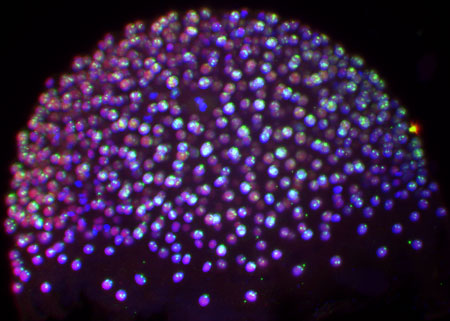The Vastenhouw Lab (based at the Max Planck Institute of Molecular Cell Biology and Genetics in Dresden, Germany) collaborated with the groups of Andrej Shevchenko (same institute) and Vasily Zaburdaev (Max Planck Institute for the Physics of Complex Systems, also in Dresden) to quantitatively address a long-standing question in developmental biology: how does an embryo determine when to start using its own genetic information?

Figure: Lightsheet micrograph showing nuclei and transcription activity in a zebrafish embryo during zygotic genome activation.
Upon fertilization, embryos rely on what their mom provided them with in the oocyte. It is only after some time that they start to use their own genome and take control over their fate. The Vastenhouw Lab now discovered that the time of this important event is determined by a competition for DNA binding between proteins that repress transcription, and ones that activate it. “What it all boils down to is a yin and yang during early development,” says Shai Joseph, first author of the publication that presents the discovery.
In addition to providing mechanistic insight into the activation of transcription during development, competition for DNA binding might be a general mechanism that is used to regulate transcription throughout development.
Reference
Competition between histone and transcription factor binding regulates the onset of transcription in zebrafish embryos. Shai R. Joseph, Máté Pálfy, Lennart Hilbert, Mukesh Kumar, Jens Karschau, Vasily Zaburdaev, Andrej Shevchenko, and Nadine L. Vastenhouw. Elife. 2017 Apr 2016.


































